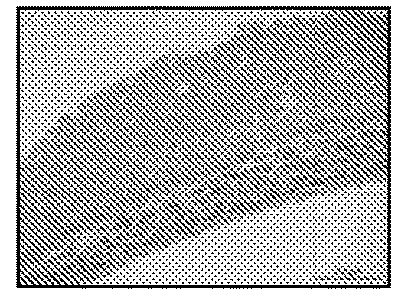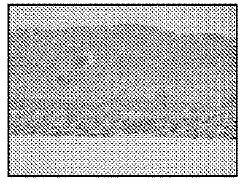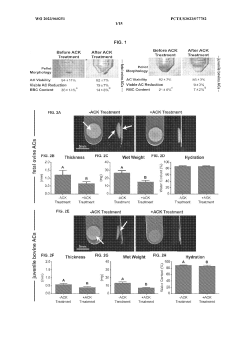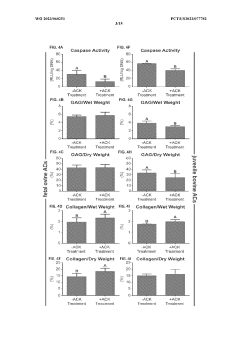Hypertonic Applications in Tissue Engineering: A Review
Hypertonic Solutions in Tissue Engineering: Background and Objectives
Hypertonic solutions have emerged as a promising tool in the field of tissue engineering, offering unique advantages in manipulating cellular behavior and tissue formation. The evolution of this technology can be traced back to early observations of osmotic effects on cells and tissues. Over the past few decades, researchers have increasingly recognized the potential of hypertonic environments to enhance various aspects of tissue engineering, from cell preservation to scaffold design and tissue maturation.
The primary objective of utilizing hypertonic solutions in tissue engineering is to create controlled microenvironments that can modulate cell function, improve tissue construct properties, and ultimately lead to more effective regenerative therapies. By altering the osmotic pressure surrounding cells and tissues, hypertonic solutions can influence cellular volume, metabolism, and gene expression, thereby directing cell fate and tissue development in ways that are not possible with traditional isotonic culture conditions.
Recent advancements in the understanding of mechanobiology and cellular responses to osmotic stress have further propelled the exploration of hypertonic applications in tissue engineering. Researchers have discovered that controlled exposure to hypertonic environments can trigger beneficial cellular responses, such as increased extracellular matrix production, enhanced cell differentiation, and improved tissue mechanical properties. These findings have opened up new avenues for optimizing tissue-engineered constructs and developing more physiologically relevant in vitro models.
The integration of hypertonic solutions into tissue engineering strategies aligns with the broader trend towards biomimetic approaches in regenerative medicine. By replicating aspects of the natural tissue microenvironment, including osmotic gradients found in certain tissues, researchers aim to create more authentic and functional engineered tissues. This approach has shown particular promise in areas such as cartilage and intervertebral disc engineering, where osmotic pressures play a crucial role in tissue homeostasis and function.
As the field progresses, the goals of hypertonic applications in tissue engineering are expanding. Current objectives include developing precise control mechanisms for osmotic manipulation, understanding the long-term effects of hypertonic exposure on engineered tissues, and translating these findings into clinically relevant therapies. Additionally, researchers are exploring the synergistic effects of combining hypertonic treatments with other tissue engineering strategies, such as mechanical stimulation and growth factor delivery, to create more comprehensive and effective tissue regeneration approaches.
Market Analysis for Hypertonic Applications in Regenerative Medicine
The market for hypertonic applications in regenerative medicine has shown significant growth potential in recent years, driven by increasing demand for advanced tissue engineering solutions and the rising prevalence of chronic diseases. The global regenerative medicine market, which encompasses hypertonic applications, was valued at approximately $13.3 billion in 2020 and is projected to reach $38.7 billion by 2026, growing at a CAGR of 19.5% during the forecast period.
Hypertonic solutions have gained traction in tissue engineering due to their ability to modulate cell behavior, enhance tissue formation, and improve overall regenerative outcomes. The market for hypertonic applications in this field is primarily segmented into orthopedics, dermatology, cardiology, and neurology, with orthopedics currently holding the largest market share.
The orthopedic segment's dominance can be attributed to the increasing incidence of musculoskeletal disorders and the growing aging population. Hypertonic solutions have shown promising results in bone and cartilage regeneration, driving their adoption in orthopedic applications. The dermatology segment is expected to witness the highest growth rate, fueled by the rising demand for advanced wound healing solutions and aesthetic treatments.
Geographically, North America currently leads the market for hypertonic applications in regenerative medicine, followed by Europe and Asia-Pacific. The United States, in particular, holds a significant market share due to its well-established healthcare infrastructure, high R&D investments, and favorable regulatory environment. However, the Asia-Pacific region is anticipated to experience the fastest growth, driven by increasing healthcare expenditure, growing awareness of advanced therapies, and improving regulatory frameworks in countries like China and Japan.
Key factors driving market growth include technological advancements in tissue engineering, increasing funding for regenerative medicine research, and the growing prevalence of chronic diseases. However, high treatment costs, stringent regulatory requirements, and ethical concerns associated with stem cell research may hinder market expansion to some extent.
The competitive landscape of the hypertonic applications market in regenerative medicine is characterized by the presence of both established players and innovative start-ups. Major companies are focusing on strategic collaborations, mergers and acquisitions, and product innovations to strengthen their market position. Additionally, there is a growing trend towards personalized medicine, which is expected to create new opportunities for hypertonic applications in tailored regenerative therapies.
Current Challenges in Hypertonic Tissue Engineering
Hypertonic tissue engineering faces several significant challenges that impede its widespread adoption and clinical translation. One of the primary obstacles is the difficulty in maintaining cell viability and functionality under hypertonic conditions. The increased osmotic pressure in hypertonic environments can lead to cellular dehydration, shrinkage, and potential damage to cellular structures. This poses a significant hurdle in developing tissue constructs that can withstand and thrive in hypertonic environments.
Another challenge lies in the complex interplay between hypertonic conditions and extracellular matrix (ECM) components. Hypertonic environments can alter the physical and chemical properties of ECM proteins, potentially affecting their ability to support cell adhesion, proliferation, and differentiation. This necessitates a deeper understanding of how hypertonic conditions influence ECM-cell interactions and the development of strategies to mitigate any adverse effects.
The optimization of culture media and supplements for hypertonic tissue engineering presents another significant challenge. Traditional culture media formulations may not be suitable for maintaining cellular health and function in hypertonic conditions. Researchers must develop specialized media compositions that can support cell growth and tissue formation while simultaneously addressing the unique demands of hypertonic environments.
Furthermore, the scalability of hypertonic tissue engineering approaches remains a considerable challenge. While small-scale experiments may demonstrate promising results, translating these findings to clinically relevant tissue sizes poses significant technical and biological hurdles. Issues such as nutrient diffusion, waste removal, and maintaining uniform hypertonic conditions throughout larger tissue constructs need to be addressed.
The long-term stability and functionality of engineered tissues under hypertonic conditions also present ongoing challenges. Researchers must develop strategies to ensure that tissues maintain their structural integrity, mechanical properties, and biological functions over extended periods in hypertonic environments. This is particularly crucial for applications where long-term tissue survival and functionality are essential.
Additionally, the regulatory landscape surrounding hypertonic tissue engineering products adds another layer of complexity. As this field advances, navigating the regulatory requirements for safety and efficacy testing of hypertonic tissue-engineered constructs will be crucial for clinical translation. Developing standardized protocols and quality control measures for hypertonic tissue engineering processes will be essential to meet regulatory standards and ensure reproducibility.
Current Hypertonic Methodologies in Tissue Engineering
01 Medical applications of hypertonic solutions
Hypertonic solutions are used in various medical applications, including treatment of edema, intracranial pressure reduction, and as a component in wound healing therapies. These solutions can help draw excess fluid from tissues and promote osmotic balance in the body.- Medical applications of hypertonic solutions: Hypertonic solutions are used in various medical applications, including wound healing, reducing edema, and treating certain medical conditions. These solutions have a higher solute concentration than body fluids, which can help draw excess fluid from tissues and promote healing.
- Formulation of hypertonic solutions: The formulation of hypertonic solutions involves careful selection of solutes and their concentrations. Common ingredients include salts, sugars, and other osmotically active compounds. The composition is designed to achieve specific osmotic effects while maintaining safety and efficacy for the intended use.
- Hypertonic solutions in cell culture and preservation: Hypertonic solutions play a crucial role in cell culture techniques and preservation of biological materials. They can be used to manipulate cell volume, induce stress responses, or protect cells during cryopreservation processes. The specific composition of these solutions is tailored to the needs of different cell types and preservation methods.
- Hypertonic solutions for ocular applications: In ophthalmology, hypertonic solutions are used for various purposes, including treating corneal edema and as eye drops for dry eye syndrome. These solutions help to draw out excess fluid from the cornea or conjunctiva, providing relief and improving visual acuity.
- Industrial and environmental applications of hypertonic solutions: Hypertonic solutions have applications beyond medicine, including industrial processes and environmental remediation. They can be used in water treatment, soil remediation, and certain manufacturing processes where osmotic effects are beneficial. The composition and concentration of these solutions are optimized for each specific application.
02 Formulation of hypertonic solutions for specific treatments
Hypertonic solutions are formulated with specific concentrations and compositions for targeted treatments. These may include saline solutions, sugar-based solutions, or combinations of electrolytes designed to address particular medical conditions or physiological imbalances.Expand Specific Solutions03 Use of hypertonic solutions in cell culture and preservation
Hypertonic solutions play a crucial role in cell culture techniques and preservation of biological samples. They are used to maintain osmotic balance, prevent cell lysis, and optimize conditions for cell growth and storage.Expand Specific Solutions04 Hypertonic solutions in ophthalmic applications
Hypertonic solutions are utilized in various ophthalmic treatments, including management of corneal edema and as a component in eye drops. These solutions help maintain proper osmotic balance in the eye and can aid in reducing swelling of ocular tissues.Expand Specific Solutions05 Development of novel hypertonic solution delivery systems
Research is ongoing to develop innovative delivery systems for hypertonic solutions, including controlled-release mechanisms, targeted delivery methods, and combination therapies. These advancements aim to improve the efficacy and precision of hypertonic solution treatments.Expand Specific Solutions
Key Players in Hypertonic Tissue Engineering Research
The field of hypertonic applications in tissue engineering is in a growth phase, with increasing market size and technological advancements. The global tissue engineering market is expanding rapidly, driven by rising demand for regenerative medicine and organ transplantation alternatives. Technological maturity varies across different applications, with companies like Organovo, Inc. and The Regents of the University of California leading in bioprinting and scaffold development. Research institutions such as the National Research Council of Canada and Tsinghua University are advancing fundamental understanding, while companies like ProKidney LLC and Satellite Biosciences, Inc. focus on specific organ regeneration technologies. The involvement of diverse players, from academic institutions to biotech firms, indicates a dynamic and competitive landscape with significant potential for innovation and market growth.
Organovo, Inc.
The Regents of the University of California
Innovative Hypertonic Approaches in Tissue Regeneration
- A method involving a 'hypothermic hold' and incubation at temperatures below 37°C, avoiding ionic, chemical, or physical cross-linkers, to improve tissue morphology, cell viability, and differentiation, allowing for the fabrication of three-dimensional engineered tissues without the need for cross-linking.
- The use of a hypotonic solution, such as ammonium chloride potassium lysing buffer (ACK buffer), to treat freshly isolated cartilage cells, selectively removing pre-apoptotic cells and enhancing the formation of biofunctional tissues by enriching for cells with favorable phenotypes, combined with cytochalasin D to improve cytoskeleton arrangement and matrix deposition.
Regulatory Considerations for Hypertonic Tissue Engineering
The regulatory landscape for hypertonic applications in tissue engineering is complex and evolving, requiring careful consideration of safety, efficacy, and ethical implications. Regulatory bodies such as the FDA in the United States and the EMA in Europe play crucial roles in overseeing the development and approval of hypertonic tissue engineering products.
One of the primary regulatory challenges is the classification of hypertonic tissue engineering products. These products often fall into a gray area between medical devices and biological products, necessitating a case-by-case evaluation. The FDA's Center for Biologics Evaluation and Research (CBER) typically takes the lead in regulating such products, applying a risk-based approach to determine the appropriate regulatory pathway.
Safety considerations are paramount in the regulatory process. Regulators require extensive preclinical and clinical data to demonstrate the safety profile of hypertonic tissue engineering applications. This includes evaluating potential adverse effects on cell viability, tissue integrity, and systemic responses to hypertonicity. Long-term safety studies are often necessary to assess the durability and stability of engineered tissues exposed to hypertonic conditions.
Efficacy assessment presents another regulatory hurdle. Demonstrating the effectiveness of hypertonic tissue engineering products often requires innovative clinical trial designs and endpoints. Regulators may require sponsors to show not only the immediate effects of hypertonic treatments but also long-term functional outcomes and tissue integration.
Quality control and manufacturing standards are critical regulatory considerations. Good Manufacturing Practices (GMP) must be adhered to throughout the production process, with particular attention to maintaining consistent osmolarity and sterility of hypertonic solutions. Regulators may require validated methods for measuring and controlling osmolarity in final products.
Ethical considerations also factor into the regulatory framework. The use of hypertonic solutions in tissue engineering may raise questions about potential off-target effects and long-term tissue remodeling. Regulatory bodies often seek input from ethics committees to address these concerns and ensure patient safety and informed consent.
As the field of hypertonic tissue engineering advances, regulatory agencies are working to develop more specific guidance documents. These aim to provide clearer pathways for product development and approval, balancing innovation with patient safety. Collaboration between researchers, industry, and regulators is essential to establish appropriate standards and accelerate the translation of hypertonic tissue engineering applications from bench to bedside.
Bioethical Implications of Hypertonic Tissue Engineering
The bioethical implications of hypertonic tissue engineering are multifaceted and require careful consideration as this technology advances. One primary concern is the potential for unintended consequences on cellular and tissue function. Hypertonic environments can induce osmotic stress, potentially altering gene expression and cellular behavior in ways that may not be fully understood or predictable. This raises questions about the long-term safety and efficacy of engineered tissues exposed to hypertonic conditions.
Another significant ethical consideration is the issue of informed consent. Patients receiving tissues or organs developed using hypertonic engineering techniques should be fully aware of the novel nature of this approach and any potential risks associated with it. This necessitates clear communication between researchers, clinicians, and patients, as well as robust protocols for obtaining and documenting informed consent.
The use of hypertonic solutions in tissue engineering also brings up questions of resource allocation and access to healthcare. If this technology proves to be significantly more effective than current methods, it could create disparities in treatment quality between those who can afford or access hypertonic-engineered tissues and those who cannot. This raises concerns about equitable distribution of healthcare resources and the potential exacerbation of existing healthcare inequalities.
Furthermore, the development of hypertonic tissue engineering techniques may involve animal testing, which brings its own set of ethical considerations. Researchers must carefully balance the potential benefits to human health against the welfare of animal subjects used in preclinical studies. This requires adherence to strict ethical guidelines for animal research and a commitment to minimizing harm and suffering.
There are also broader societal implications to consider. As hypertonic tissue engineering advances, it may challenge existing regulatory frameworks and necessitate the development of new guidelines and oversight mechanisms. This could involve complex debates about the boundaries between natural and engineered tissues, and how to classify and regulate these novel biological constructs.
Lastly, the potential for hypertonic tissue engineering to extend human capabilities or lifespan raises profound questions about human enhancement and the nature of medical intervention. As the technology progresses, society will need to grapple with where to draw the line between therapeutic applications and enhancement, and how to navigate the ethical terrain of potentially altering human biology in fundamental ways.







